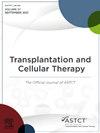High Melphalan Exposure Increases the Risk of Graft-Versus-Host Disease in Pediatric Patients Undergoing Alpha-Beta T-Cell Depleted Haploidentical Transplantation
IF 3.6
3区 医学
Q2 HEMATOLOGY
引用次数: 0
Abstract
Background
Melphalan is often used as the backbone agent for conditioning prior to A/B-T-cell depleted (A/B-TCD) hematopoietic cell transplant (HCT) due to lower rates of organ toxicity compared to busulfan or total-body irradiation, albeit with significant mucosal injury. Traditional dosing based on body-surface-area (BSA) may result in non-optimal melphalan exposure among certain patient subsets.
Objectives
As mucosal injury is linked to initiation of alloreactivity, we hypothesized that high exposure of melphalan predicted via a pharmacokinetic (PK) model would be associated with an increased risk of acute graft-versus-host disease (aGVHD).
Study Design
We performed an analysis of 85 patients who underwent A/B-TCD haploidentical HCT on 2 prospective trials using melphalan-based conditioning for treatment of malignancy at 3 centers from 2015 to 2024. Most patients (61.2%) received a total dose of melphalan at 140 mg/m2 using actual body weight; others received a dose adjusted for obesity or age <2 years. We analyzed outcomes based on whether melphalan exposure was above or below the median exposure for the group.
Results
The 100-day cumulative incidences of engraftment syndrome (ES), grade II-IV aGVHD, and grade III-IV aGVHD were 34.2%, 24.8%, and 17.1%, respectively. The 3-year cumulative incidence of chronic GVHD (cGVHD), non-relapse mortality (NRM), and relapse were 17.5%, 8.7%, 21.8%, respectively. The 3-year cumulative incidence of disease-free survival (DFS) and severe GVHD-relapse-free survival (GRFS) were 71.4% and 55.6%, respectively. ES was significantly associated with the subsequent development of aGVHD, both grade II-IV (41.4% vs. 17.3% in those with and without ES, P = .01) and grade III-IV (34.5% vs. 8.5% in those with and without ES; P = .003). Chronic GVHD occurred at significantly higher rates in patients with prior Grade II-IV (66.7% vs. 0% for Grade 0-I; P < .001) and Grade III-IV aGVHD (75% vs. 4.3% for Grade 0-II; P < .001). Compared to non-obese patients, the PK model predicted lower melphalan exposure (P = .02) in obese patients where adjusted ideal body weight was utilized, suggesting overcorrection of the dose. There was no impact of melphalan exposure on immunologic rejection. The median melphalan exposure was 6.81 mg*hr/L (range, 4.4-8.8). Compared to a melphalan exposure ≤6.8 mg*hr/L, a melphalan exposure >6.8 mg*hr/L was associated with a higher incidence of ES (48.8% vs. 19.1%; P = .005), grade II-IV aGVHD (39.3% vs. 10.1%; P = .002), and grade III-IV aGVHD (31.5% vs. 2.5%; P < .001). The 3-year incidence of cGVHD was 27.2% in those with high predicted melphalan exposure compared to 7.4% for low exposure (P = .03); with no difference in 3-year NRM incidence (9.2% vs. 7.7%; P = .82) or 3-year relapse incidence (16.8% vs. 27.6%; P = .31) for high compared to low exposure. However, GRFS was significantly worse in patients with high exposure (46.4%) vs. low exposure (64.6%; P = .02).
Conclusions
High melphalan exposure predicted by a validated population PK model is associated with an increased likelihood of developing ES and subsequently acute and chronic GVHD. Given that a substantial number of patients already require adjustment of standard BSA-based dosing for young age or obesity, a prospective trial of model-based dosing to individualize melphalan exposure is warranted to confirm these results.
高剂量的Melphalan暴露会增加接受α - β t细胞耗尽单倍体移植的儿科患者发生移植物抗宿主病的风险。
背景:美法仑通常被用作A/B-T细胞去势(A/B-TCD)造血细胞移植(HCT)前调理的主药,因为与丁胺苯磺胺或全身照射相比,美法仑的器官毒性较低,但会造成严重的粘膜损伤。基于体表面积(BSA)的传统剂量可能会导致某些患者亚群的美法仑暴露量不理想:由于粘膜损伤与异体反应的开始有关,我们假设通过药代动力学(PK)模型预测的美法仑高暴露量与急性移植物抗宿主病(aGVHD)风险的增加有关:我们对2015-2024年在三个中心进行的两项前瞻性试验中接受A/B-TCD单倍体HCT的85名患者进行了分析,这两项试验均使用美法仑为基础的调理治疗恶性肿瘤。大多数患者(61.2%)根据实际体重接受了140毫克/平方米的美法仑总剂量;其他患者则根据肥胖或年龄调整了剂量 结果:100天内移植综合征(ES)、II-IV级aGVHD和III-IV级aGVHD的累计发生率分别为34.2%、24.8%和17.1%。慢性GVHD(cGVHD)、非复发死亡率(NRM)和复发的3年累计发生率分别为17.5%、8.7%和21.8%。无病生存期(DFS)和严重GVHD-无复发生存期(GRFS)的3年累积发生率分别为71.4%和55.6%。ES与随后发生的AGVHD明显相关,包括II-IV级(有ES和无ES者分别为41.4%和17.3%,P=0.01)和III-IV级(有ES和无ES者分别为34.5%和8.5%,P=0.003)。慢性GVHD在II-IV级患者中的发生率明显更高(66.7%对0-I级的0%;p6.8 mg*hr/L与ES(48.8%对19.1%;p=0.005)、II-IV级aGVHD(39.3%对10.1%;p=0.002)和III-IV级aGVHD(31.5%对2.5%;p结论:根据经过验证的人群 PK 模型预测,美法仑暴露量高与罹患 ES 及随后罹患急性和慢性 GVHD 的可能性增加有关。鉴于大量患者已经需要根据年龄或肥胖程度调整基于 BSA 的标准剂量,因此有必要进行基于模型的剂量个体化前瞻性试验,以证实这些结果。
本文章由计算机程序翻译,如有差异,请以英文原文为准。
求助全文
约1分钟内获得全文
求助全文
来源期刊

Transplantation and Cellular Therapy
Medicine-Hematology
CiteScore
7.00
自引率
15.60%
发文量
1061
审稿时长
51 days
 求助内容:
求助内容: 应助结果提醒方式:
应助结果提醒方式:


